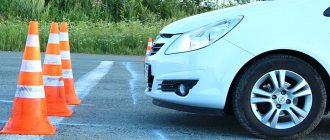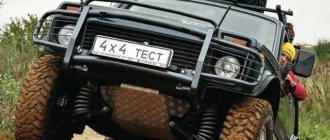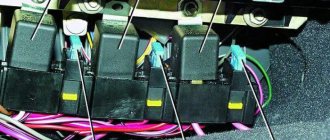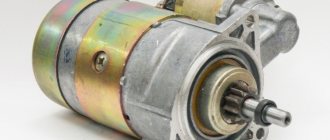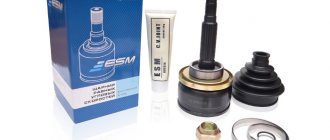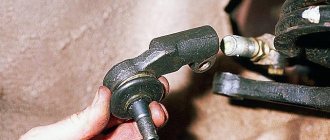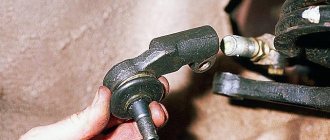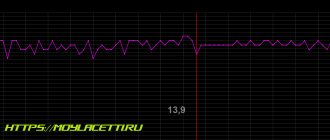Having received a driver's license and bought a car, it is worth driving for some time on not very busy roads and practicing parking in places where this action can be done as simply as possible. This must be done not only because you still have too little driving experience, but also because you need to get used to your new iron friend and feel the dimensions of the car. At this stage, many people wonder how to feel the dimensions of the car if I am a beginner. It is the sense of size that allows you to perform any maneuvers without violating your own and others’ safety.
Recommendations and tips: how to feel the dimensions of a car.
Dimensions
The concept of dimensions usually refers to the height, length and width of the car. But the machine is not only in a static position; it also has dynamic dimensions. Those who have carefully studied in a driving school know that there are six main indicators:
- A straight line that continues the wheels – left and right.
- Continuation line of the front bumper.
- Rear bumper.
- Front axle.
- Rear axle.
These parameters are completely different for different brands and not only beginners, but also quite experienced drivers need to get used to them. You can feel them well only after some time has passed - this is the experience of traveling in this particular car. Only after feeling his car, the driver can easily fit into a dense traffic flow or park in a very small and inconvenient space. The same feeling allows you to avoid bumps on the road or move on rough terrain. It’s quite easy to spot a novice driving; many of them try to crane their necks during the trip and try to look at the road in front of the bumper. Such drivers can often see various minor damage to the bumper, front and rear, or headlights. All this is most often the result of unsuccessful parking. You can try to avoid this, because even minor repairs often cost a very tidy sum.
Special markup
For this training, you need to find a site with a flat surface, preferably asphalt. Additional materials are a can of spray paint or chalk. The following lines must be drawn on the site:
- 1 – a line that “continues” the right wheels both forward and backward.
- 2 – line of left wheels.
- 3 – continues the line of the front bumper.
- 4 – rear bumper line.
- 5 – continuation of the axis of the front wheels.
- 6 – continuation of the axis of the rear wheels.
Sit in the driver's seat and assume the correct riding position. Mentally continue the lines of the wheels (1 and 2), mark the points where they intersect with the front panel, where it connects to the windshield. You can use adhesive tape or colored stickers for labels. They will help you navigate exactly where the wheels will move and the trajectory of their movement. When you learn to feel the dimensions, you will be able to remove these marks: your trained brain itself will figure out which section of the road the wheels will go on.
Developing a sense of size
For a good driver, the feeling of the car occurs automatically, as if subconsciously, and the goal of any beginner is to achieve exactly this level. To the question of how a beginner can get used to the size, the answer is clear - you need to not be lazy and do some self-preparation. Experienced motorists and driving instructors talk about several groups of possible complexes:
- Completing a complex of individual, or self-guided, training using improvised or stationary means.
- Individual preparatory work on the car.
- Completing training using assistive electronic devices.
Beacons
For such training, you can use special plastic cones or make similar ones yourself. It is enough to fill ordinary plastic bottles with sand and stick thin long poles into them. It is best to mark them with a bright flag (the brighter the better) - the main thing is that it should be clearly visible.
Place two beacons in front of the car. When approaching, you only need to lightly touch them, but not knock them over. You can also “feel” the rear bumper. Side dimensions will help you feel the same marks installed on the sides of the car. To begin with, they should be far away, then you need to move them closer and closer as soon as you can successfully drive between them. The shorter the distance, and you can successfully overcome it, the better you will be able to park and drive into narrow streets.
Individual car preparation
The adequacy of driving will depend on how comfortable, and most importantly, how correctly the driver sits behind the wheel. Proper seating reduces unnecessary driver movements and speeds up the decision-making process. This is achieved due to the fact that the driver has the correct position of his arms and legs, and in addition, sufficient visibility, without unnecessary bending and peeking. To achieve the optimal fit, the driver needs to make a special adjustment. Adjusting the driver's seat and steering wheel
- Sit in the driver's seat and adjust it just for you. Ideally, you need to fully depress the clutch and move the seat forward or backward so that it is comfortable and there is no desire to stretch. The backrest is adjustable so that when using your legs you do not have to move your entire body.
- Do the same with the steering wheel - your palm should fit between the rim of the steering wheel and your knees, and at the same time the second hand should be extended above the steering wheel and touch its top point with your wrist.
Important aspects
The main mistake of beginners is the desire to see what is happening in front of the bumper; this habit is very undesirable. In addition, it is dangerous when driving: when you drive, you need to look only in front of you, and not in front of the bumper.
When you reverse park, it is important to adjust the mirrors correctly; they will become your main assistants. This setting looks like this: the external mirrors should be directed and show the rear axle wheels to the driver. External ones are used to feel the lateral outlines. Pay attention to the outermost area of the exterior mirrors.
When driving along a highway outside the city, if you need to change lanes, look in the appropriate side mirror. Often, inexperienced drivers cut off other road users because they do not understand what they actually need to do with these mirrors. You can only change lanes when you can see in the mirror the entire car that is moving behind you.
Exercises to bring the feeling of a car to automaticity
There is a fairly wide variety of training options for inexperienced drivers, which allow you to quickly feel the dimensions of the car. We want to introduce you to the most effective ones.
Beacons
This is the simplest, but no less useful way to feel the dimensions. For this method we will need the following items that are absolutely safe for the car:
- Cones of any bright color.
- Plastic bottles filled with sand. For better visibility, you can stick bright flags into the bottles.
- Sacks or cardboard boxes filled with something very soft.
- Old tires.
The next step will be to install these beacons. Now you can start working directly.
- The driver must stop his car so that his front bumper, first the central part, and then the sides, touches the installed beacon. It’s important to touch, and not knock over or miss – this happens about the tenth or fifteenth time.
- Then you need to practice the same exercise with the rear bumper. These exercises should be brought to automaticity.
- After completing the first two stages, you need to move on. We mark with beacons the contours of two cars with a distance of 9 - 10 meters. Next, we begin to practice the parallel parking method, which is considered quite difficult.
- We put tall sticks in bottles with sand that will imitate gates and begin to work out the passage. First, the distance between the bottles should be approximately equal to the width of your car + 1 meter. Then we gradually narrow the distance, reducing it by 10 cm each time. The exercise will be considered completed if you can drive the car into a gap that exceeds the dimensions of the vehicle by only 10 cm.
Selection of standard landmarks
Often, beginners forget that there is at least another meter of the car body in front of them. This must be remembered and constantly kept in mind in order to properly maintain distance in traffic jams and during normal traffic. But what should you do to feel the side dimensions of the car?
Pay attention to the left dividing strip. While driving, it should seem to “go” to the lower left corner of the windshield. In fact, this means that there is a distance of about 70 cm between the car body and the dividing line. You should also navigate along the right side in the same way.
The median or curb on the right must also intersect the lower right corner of the windshield. This will help when parallel parking on the right side of the road - if you follow this rule, you can be sure that the car will not touch the curb with its wheel and at the same time will not be parked too far from it.
To estimate the distance from the car to objects located behind, it is best to use the left side mirror - the entire body of the car, the length of which is usually approximately three meters, should be visible through it.
Problems with perception
The dimensions of trucks are not easy to understand even for experienced drivers. But there are some tricks that allow both beginners and long-distance drivers to perceive the distances to neighboring cars in more detail. To assess the reach of the hood, extend it as far as possible towards the steering wheel. But there are cars where even in this position the nose of the car is not visible. This is where decorative elements on the hood come to the rescue: flags, an antenna, a figurine.
When modernizing a car, they try to install decorative elements on the very edge of the hood. After this innovation, there will be no problems with parking in front. Reverse maneuvers are made easier by installing parking sensors. Fortunately, their cost is already low. Models from China will cost several hundred rubles, installation is simple, and you can do it yourself or give the service half of the cost of the gadget for installation.
To improve visibility, many drivers stick convex round mirrors on top of the standard ones. Replace the mirror in the cabin with a viewing one. They install a similar one above the trunk glass in station wagons and minivans. You can use a rear view camera if technically possible.
An easy way to park safely is to have a friend help you. The passenger can get out and manage the process.
Action plan
The first rule of an experienced driver: “If you have doubts due to lack of visibility or due to poor visibility, poor condition, then you need to stop and not be lazy to go outside and look.” Intuitively, while driving, the desire often comes to wait a few seconds and check what is overboard.
This rule must always be followed during any type of maneuver. This way, the highest level of aerobatics is achieved, the safety of your car and the health of passengers. Even when driving through a green light right away, you should once again make sure that traffic is safe by turning your head left and right. So when parking, you should constantly monitor three viewpoints at once. At any second, a restless baby could sit under your bumper in the yard.
Every experienced motorist must feel the dimensions of his car like his own body parts. Sometimes difficult situations occur on the roads that require a good sense of dimensions. They often occur when driving in city traffic jams and in parking lots when entering a garage. How can a beginner quickly learn the dimensions of a car so as not to cause emergency situations? To avoid such incidents, experts have come up with exercises that improve driving skills.
Hitting
The hitting exercise is also not difficult, but you need to have good practice in order to repeat the results obtained without errors. You need to place an empty plastic bottle on the platform, and take turns running over it with your front wheels. It seems that everything is easy, but this is a mistaken opinion. Beginners often miss. When you do the exercises effortlessly, make it more difficult by adding speed when hitting. To consolidate the exercise you have learned, do a run on an empty area at a speed of 60 km/h. This condition will require the correct sense of size. If you exceed the specified speed, you have every chance of finding yourself in a dangerous emergency situation. At the third stage, you need to run over the bottle and simultaneously make a turn. Even savvy car owners make mistakes when performing this exercise. This complexity helps to achieve high results. It is not necessary to use a bottle; it is enough to replace it with an object that makes a loud sound and is easily compressed, but in no case should it fly out from under the wheels. A cardboard box folded in half can be an excellent substitute.
Training Options
If you want to figure out how to feel the dimensions of a car, you should not forget about a simple rule: each driver has individual characteristics, and the approach is chosen by him. It all depends on driving experience and the ability to focus on one problem. Everyone's visual organ differs in the degree of vigilance and depth of perception of objects.
There are classic training sessions for getting used to your own transport. The first instructive lesson is to drive backwards into the garage exactly according to the mirrors without parking sensors. The room can be imitated with bottles, ropes, road caps. The second way to consolidate your skills is by accelerating and braking within specified limits. You need to stop your wheels exactly between the lines located half a meter from each other.
